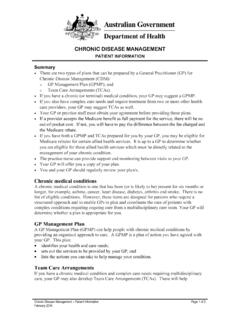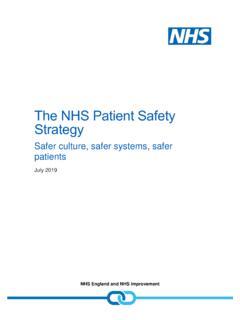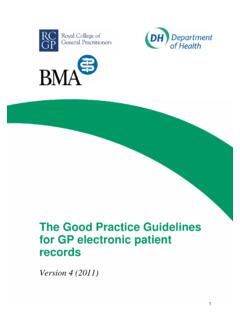Transcription of A promise to learn – a commitment to act – Improving the …
1 A promise to learn a commitment to actImproving the Safety of patients in EnglandNational Advisory Group on the Safety of patients in EnglandAugust 20133 ContentsExecutive Summary 4A promise to learn - a commitment to act: Improving the safety of patients in England 7 Recommendations 13I. The overarching goal 14II. Leadership 15 III. Patient and public involvement 18IV. Staff 21V. Training and capacity building 24VI. Measurement and transparency 27 VII. Structures and regulation 30 VIII. Enforcement 33IX. Moving forward 36 Annex A: A note on our methodology 39 Annex B: Letters 40 Letter to Senior Government Officials and Senior Executives in the Health Service 40 Letter to the people of England 42 Letter to the clinicians, managers, and all staff of the NHS 44 Annex C: List of Advisory Group Members 464 Executive SummaryPlace the quality of patient care, especially patient safety, above all other , empower, and hear patients and carers at all whole-heartedly the growth and development of all staff, including their ability and support to improve the processes in which they transparency unequivocally and everywhere, in the service of accountability, trust, and the growth of its core, the NHS remains a world-leading example of commitment to health and health care as a human right the endeavour of a whole society to ensure that all people in their time of need are supported, cared for, and healed.
2 It is a fine institution. But the events at Mid Staffordshire have triggered a need to re-examine what the NHS does and determine how it can improve further. The only conceivably worthy honour due to those harmed is to make changes that will save other people and other places from similar job has been to study the various accounts of Mid Staffordshire, as well as the recommendations of Robert Francis and others, to distil for Government and the NHS the lessons learned, and to specify the changes that are following are some of the problems we have identified: Patient safety problems exist throughout the NHS as with every other health care system in the world. NHS staff are not to blame in the vast majority of cases it is the systems, procedures, conditions, environment and constraints they face that lead to patient safety problems. Incorrect priorities do damage: other goals are important, but the central focus must always be on patients .
3 In some instances, including Mid Staffordshire, clear warning signals abounded and were not heeded, especially the voices of patients and carers. When responsibility is diffused, it is not clearly owned: with too many in charge, no-one is. Improvement requires a system of support: the NHS needs a considered, resourced and driven agenda of capability-building in order to deliver continuous improvement. Fear is toxic to both safety and address these issues the system must: Recognise with clarity and courage the need for wide systemic change. Abandon blame as a tool and trust the goodwill and good intentions of the staff. Reassert the primacy of working with patients and carers to achieve health care goals. Use quantitative targets with caution. Such goals do have an important role en route to progress, but should never displace the primary goal of better Summary5 Recognise that transparency is essential and expect and insist on it.
4 Ensure that responsibility for functions related to safety and improvement are vested clearly and simply. Give the people of the NHS career-long help to learn , master and apply modern methods for quality control, quality improvement and quality planning. Make sure pride and joy in work, not fear, infuse the most important single change in the NHS in response to this report would be for it to become, more than ever before, a system devoted to continual learning and improvement of patient care, top to bottom and end to have made specific recommendations around this point, including the need for improve training and education, and for NHS England to support a network of safety improvement collaboratives to identify and spread safety improvement approaches across the ten recommendations are as follows:1. The NHS should continually and forever reduce patient harm by embracing wholeheartedly an ethic of All leaders concerned with NHS healthcare political, regulatory, governance, executive, clinical and advocacy should place quality of care in general, and patient safety in particular, at the top of their priorities for investment, inquiry, improvement, regular reporting, encouragement and patients and their carers should be present, powerful and involved at all levels of healthcare organisations from wards to the boards of Government, Health Education England and NHS England should assure that sufficient staff are available to meet the NHS s needs now and in the future.
5 Healthcare organisations should ensure that staff are present in appropriate numbers to provide safe care at all times and are Mastery of quality and patient safety sciences and practices should be part of initial preparation and lifelong education of all health care professionals, including managers and The NHS should become a learning organisation. Its leaders should create and support the capability for learning, and therefore change, at scale, within the Transparency should be complete, timely and unequivocal. All data on quality and safety, whether assembled by government, organisations, or professional societies, should be shared in a timely fashion with all parties who want it, including, in accessible form, with the All organisations should seek out the patient and carer voice as an essential asset in monitoring the safety and quality of Supervisory and regulatory systems should be simple and clear.
6 They should avoid diffusion of responsibility. They should be respectful of the goodwill and sound intention of the vast majority of staff. All incentives should point in the same We support responsive regulation of organisations, with a hierarchy of responses. Recourse to criminal sanctions should be extremely rare, and should function primarily as a deterrent to wilful or reckless neglect or NATIONAL ADVISORY GROUP REPORT6 The NHS in England can become the safest health care system in the world. That will require unified will, optimism, investment, and change. Everyone can and should help. And, it will require a culture firmly rooted in continual improvement. Rules, standards, regulations and enforcement have a place in the pursuit of quality, but they pale in potential compared to the power of pervasive and constant promise to learn a commitment to act:7A promise to learn a commitment to act: Improving the safety of patients in EnglandWe do not need to recite the details of the tragedy of Mid-Staffordshire in this report.
7 Many people probably died from avoidable causes, and many more suffered unnecessary indignities and harm. The details are catalogued for posterity in Robert Francis s historic report; and the story is now indelibly part of the history of the NHS in only conceivably worthy honour due to those harmed is to make changes that will save other people and other places from similar harm. It would add tragedy to tragedy if the nation failed to learn from what happened, and to put those lessons to work. Without ever forgetting what has happened, the point now is to move doubt the NHS can do that, perhaps better than any other health care system in the world. The wave of concern that led to commissioning this report ought not to obscure the enormous strengths of the NHS, its positive achievements, or its even greater its core and concept, the NHS has been and remains a world-leading example of commitment to health and health care as a human right the endeavour of a whole society to ensure that all people in their time of need are supported, cared for, and healed.
8 The vast majority of those who serve in the NHS clinicians, staff, managers, executives, and boards, contractors and partners try every day to help to the very best of their abilities, and with deep and appropriate pride in their mission. This Advisory Group recommends important changes that we believe will lead to an even better and safer NHS, but we do not thereby suggest that the NHS has fundamentally lost its way. It is a fine institution that can and should now become much job from March 2013 through to July 2013 has been to study the various available accounts of Mid Staffordshire, as well as the recommendations of Robert Francis and others, to distil for Government and the NHS the lessons learned, and to specify the changes that are announcing our work, the Prime Minister boldly suggested that we might help the NHS achieve zero harm. We welcomed this ambitious call, but also agreed from the beginning that even the aims for improvement what the NHS should strive to achieve and how quickly would be subjects for our deliberations, and not set by others.
9 We were formed as, and we remain, an independent Advisory Group, relying on our best thinking, not on outside instruction, for our cannot and do not claim comprehensiveness in what we recommend. We knew that we would choose to remain silent on many of the Francis Report s 290 recommendations, and that we would not try to comment on everything important for the NHS to do next in the wake of Mid Staffordshire. Further, while we 1 This report is focused on the NHS in England and where we say NHS we are referring to the NHS in England. However, the lessons are applicable to other healthcare systems, both within the rest of the UK and NATIONAL ADVISORY GROUP REPORT8wholeheartedly support changes in the configuration of services and detailed processes of care that will improve safety and quality, we do not in this report attempt to prescribe those changes. That is better left to commissioners and to the people who give care; they, not we, are the experts in care believe that the actions we propose are necessary, but they are not sufficient to secure a robust future for safety in the NHS.
10 We are only one among many who will together help establish and maintain a better course. Indeed, several fine reports and studies overlapping our charge have appeared during the period of our work. Important among them is the recent Keogh Review, whose recommendations we problemsMotivating our recommendations are findings that we gathered from prior reports (those of Robert Francis and others), the statements of patients and other experts, the research evidence, and our own experience. Among the most important of these findings are the following:1. Patient safety problems exist throughout the NHS: The Mid Staffordshire tragedy may be the most notorious recent lapse in care in the English NHS, but it is not unique. A few other trusts show signs that warrant prompt further scrutiny and, when appropriate, intervention, such as the Keogh review has recently ably modelled. More generally, like every other health care system in the world, the NHS experiences repeated defects in patient safety, and too many patients and carers suffer as a result.













